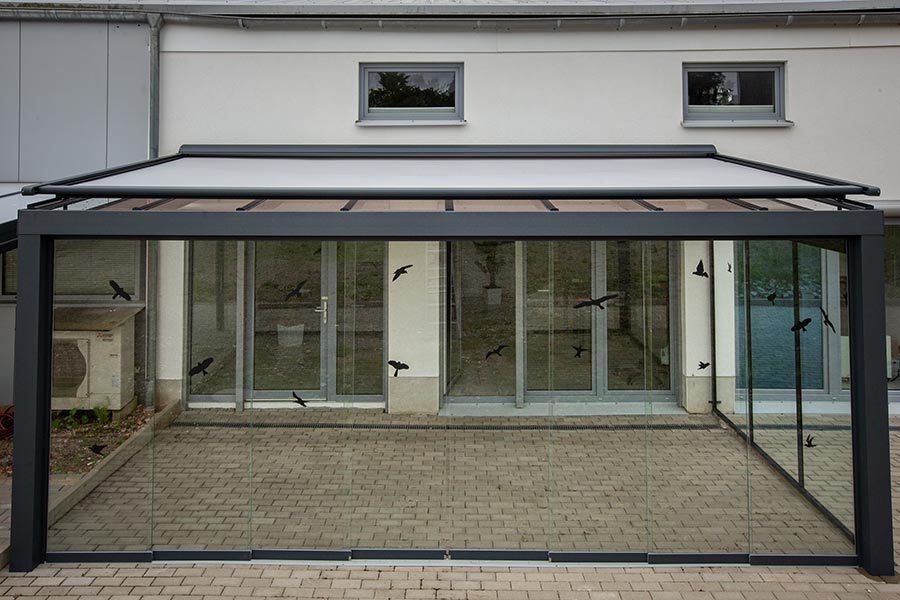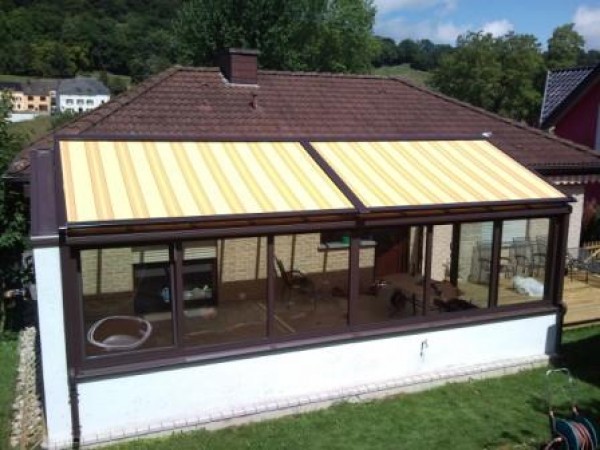Winter garden awnings
Conservatory awnings conservatory shades, patio roof awnings, patio shades.
Conservatories are a popular addition to many homes, as they create a connection between the indoors and outdoors while letting in a lot of natural light. However, the intense sunlight in summer can be uncomfortable and proper shading is essential to make the conservatory a comfortable living space.
There are several ways to shade a conservatory. The most commonly used methods are roller blinds, venetian blinds, awnings and pergola shades.
Roller blinds and venetian blinds are the simplest and most cost-effective way to shade a conservatory. They can be manually or electrically operated and are available in a variety of colors and designs. They are easy to install and can be easily adjusted to let in the desired amount of sunlight.
Awnings are another popular choice for conservatory shades. They provide flexible and temporary shading that can be easily retracted and extended. Awnings are available in various sizes and can be mounted on the wall or ceiling. However, they are usually more expensive than roller blinds or venetian blinds.
Pergola shades are another option for shading a conservatory. They consist of a sturdy frame covered with shade material such as fabric or aluminum. Pergolas provide durable and attractive shade that blends well with the garden. However, they are usually more expensive than roller blinds, venetian blinds or awnings.
No matter what type of conservatory shading you choose, it’s important that it meets individual requirements and lets in the desired amount of sunlight. Careful planning and advice from experts can help make the right choice. With the right shading, you can enjoy the winter garden as a pleasant living space all year round.
What is a winter garden awning?
A conservatory awning is a type of awning designed specifically for use in conservatories. It serves to protect the conservatory from UV radiation, rain and heat, and at the same time increases the flexibility in the conservatory. Conservatory awnings can be available in a variety of sizes and styles to meet the individual requirements and tastes of the user. They can be manually or electrically operated and there are also various light control and blackout options available.
Popularity of winter garden terrace awnings
Conservatory patio awnings have become increasingly popular in recent years as a great way to extend outdoor living space while providing protection from the elements and UV rays. They allow you to enjoy the winter garden in any weather and at any time of day.
Another reason for the popularity of conservatory terrace awnings is the ability to adjust the awning to the current weather conditions, regulating the intensity of light and protection from UV rays. The possibility of automatic control of the awning increases flexibility and convenience in the winter garden.
With the different designs and materials available, you can also improve the look of the conservatory and match it to the architecture of the building.
All of these factors contribute to the growing popularity of conservatory patio awnings, which are a great addition to any conservatory.


Advantages of winter garden awnings
Conservatory awnings offer a variety of benefits, including:
-
Protection from UV radiation: conservatory awnings block UV rays, providing a natural shade that helps prevent skin cancer and other health problems caused by excessive UV exposure.
-
Rain protection: conservatory awnings provide protection from rain and moisture, which helps to keep the interior of the conservatory dry and comfortable.
-
Heat dissipation: conservatory awnings can reduce the heat in the conservatory by providing shade and improving air circulation.
-
Increasing flexibility: conservatory awnings increase the flexibility in the conservatory, as they allow to enjoy the conservatory in any weather and at any time of day.
-
Increasing the living space: conservatory awnings increase the outdoor living space and turn the conservatory into an additional living area.
-
Increasing property value: conservatory awnings increase the value of property, as they extend the outdoor living space and make the conservatory more attractive.
-
Automatic control: conservatory awnings can be controlled automatically, which increases the flexibility and convenience in the conservatory.
Shading from above or from below? Under-glass shading or rather from above?
The choice between shading from above or below depends on individual requirements and preferences.
Shading from above: Awnings that shade from above are usually larger and provide a larger shading area. They are also more suitable for covering large areas, such as a terrace or a winter garden. They can also provide greater flexibility in terms of tilt angles and light control.
Shading from above the terrace roof is more eve:
In fact, shading from the top of the patio roof is often more effective because it provides a larger shading area and is better suited to cover large areas.
Awnings that shade from above can allow the shade to fall over a larger area, providing a larger shading area. Therefore, they are particularly suitable for use in winter gardens or terraces that need to cover large areas. The ability to adjust the angle of inclination of the awning allows you to regulate the light in the desired way and regulate the intensity of light in the conservatory or on the terrace.
Since conservatory terrace awnings shade from above, you can also better regulate the lighting in the conservatory or terrace and ensure that the light inside the conservatory or terrace is comfortable and not too bright.
Shading from below: Awnings that shade from below are usually smaller and provide a smaller shading area. They are better for covering smaller areas, such as a table or seating area. They can also provide greater privacy by shielding the view from below.
It is important to consider individual requirements and preferences before choosing a type of shading to ensure that the awning chosen will meet expectations and fulfill requirements.
Structure and mode of operation
A conservatory awning consists of several components that work together to create the shade and protection. The structure and operation of a conservatory awning are as follows:
-
Awning cloth: The awning cloth is the actual material that creates the shade. It is made of robust and durable materials that are resistant to weather conditions and UV rays. It can be controlled manually or electrically.
-
Awning arm – guide rails: The awning arm is the frame on which the awning fabric is fixed. It is made of sturdy and durable materials that ensure safe and stable support of the awning canvas.
-
Awning box: The awning box is the housing that houses the motor and controls. It protects the electronic components from the weather and allows electrical control of the awning.
-
Awning motor: The awning motor is the electrical device that rolls the awning up and down. It allows automatic control of the awning and can also be controlled manually.
-
Rain and wind sensors: Rain and wind sensors are optional components that allow the awning to automatically retract and extend depending on weather conditions.
Winter garden awnings can be mounted on the wall, ceiling or roof, depending on the requirements and architecture of the building.
Possible control and automation options
There are various control and automation options for conservatory awnings, which allow the awning to be controlled automatically and flexibly. Some of these options are:
-
Remote control: A remote control allows you to control the awning from another location, such as a seating area or a window.
-
Smartphone app: A smartphone app allows the awning to be controlled via a mobile application installed on a smartphone or tablet.
-
Schedule: A schedule allows the awning to automatically retract or extend at a specific time of day or on specific days.
-
Rain and wind sensors: Rain and wind sensors allow the awning to retract automatically when it rains or when the wind is too strong.
-
Sun ray sensors: A sun ray sensor allows the awning to be automatically extended or retracted depending on the intensity of the sun’s rays.
-
Home Automation Systems: Conservatory awnings can also be integrated into smart home automation systems, which allow the awning to be controlled via voice command or a smartphone app and included in automated scenes.
These control and automation options increase the flexibility and convenience of using the conservatory awning.
Possible applications
Conservatory awnings are versatile and offer a wide range of applications. Some of these uses include:
-
Protection from sunlight and rain: Conservatory awnings provide protection from UV rays and rain, which helps to keep the outdoor living space comfortable and safe.
-
Extension of living space: conservatory awnings allow to extend the outdoor living space and turn the conservatory into an additional living area.
-
Use in private: conservatory awnings are ideal for use in private gardens, terraces and conservatories, providing protection from the weather and UV rays for the family and guests.
-
Commercial use: conservatory awnings are also suitable for use in commercial areas, such as restaurants, hotels, cafes and shopping centers. They provide protection from the weather and UV rays for customers.
Recommendations for cleaning and maintenance
To maximize the life and performance of the conservatory awning, it is important to perform regular cleaning and maintenance. Here are some recommendations for cleaning and maintenance of winter garden awnings:
-
Regular cleaning: It is important to regularly clean the awning cloth and arms from dust and dirt. To do this, use a soft brush or a vacuum cleaner with a brush. Avoid cleaning the cloth with water or chemicals as this may damage the paint and materials.
-
Lubrication: Occasionally add a little oil or grease to the joints and bearings of the arms to ensure smooth operation.
-
Check the screws and bolts: Periodically check the screws and bolts holding the awning to make sure they are tight and show no signs of rust or corrosion.
-
Checking the safety: make sure that the awning is securely fastened to the wall or roof
Visit our exhibition
Metallbau Görres GmbH
Commercial area Zingsheim South 39
53947 Netterheim Zingsheim
Monday to Friday 08:00 – 16:00
Saturday by appointment
Feel free to arrange a personal appointment!
Financing and leasing options
There are several financing and leasing options for conservatory awnings that allow you to split and finance the cost of purchasing an awning. Some of these options are:
-
Financing: there are several financing options, such as installment loans or cash advances, that allow you to split the cost of purchasing a conservatory awning and repay it in monthly installments.
-
Leasing: There are also leasing options for conservatory awnings, where you rent the awning instead of buying it. This allows you to split the cost of purchasing an awning and repay it in monthly installments.
-
Credit cards: some manufacturers and retailers offer the possibility of financing the cost of a conservatory awning with a credit card.
-
Government incentives: there are also some government programs that offer financial assistance for the purchase of conservatory awnings, depending on which country and region you are in.
It is important to familiarize yourself with the various financing and leasing options and select the best option for your individual needs and requirements.
Summary of the advantages of winter garden terrace awnings
Conservatory patio awnings offer a variety of benefits, including:
-
Protection from sunlight and rain: they protect from UV radiation and rain, which helps to keep the outdoor living space comfortable and safe.
-
Extension of living space: they allow you to expand the outdoor living space and turn the winter garden into an additional living area.
-
Control and automation options: They can be controlled automatically and flexibly, which facilitates the use of the awning.
-
Protection from UV radiation: they provide protection from harmful UV rays, which is especially important to protect the skin from sunburn and long-term damage.
-
Increasing the architecture: they can help improve the look and aesthetics of a building and increase the value of the building.
-
Versatility: conservatory patio awnings can be used in both residential and commercial applications, for a variety of uses.
Recommendations for the selection and use of winter garden shades
mendations for the selection and use of winter garden shading are:
-
Consider your specific requirements: Consider what kind of protection and shade you need and what type of conservatory shading is best. Also consider the size and orientation of the winter garden.
-
Choose a high-quality manufacturer: choose a manufacturer that offers a wide range of winter garden shades and is characterized by high quality and durability.
-
Consider control and automation options: Consider whether you need automated control options such as schedules, rain and wind sensors, or a smartphone app to flexibly and conveniently control conservatory shades.
-
Consider maintenance and cleaning: Consider how easily conservatory shades can be maintained and cleaned to extend their life.
-
Financing and Leasing Options: Learn about the various financing and leasing options available to help finance the cost of purchasing conservatory shades.
-
Consider the permits: Find out about the permits required to install conservatory shades and make sure all necessary permits are obtained before you begin installation.
